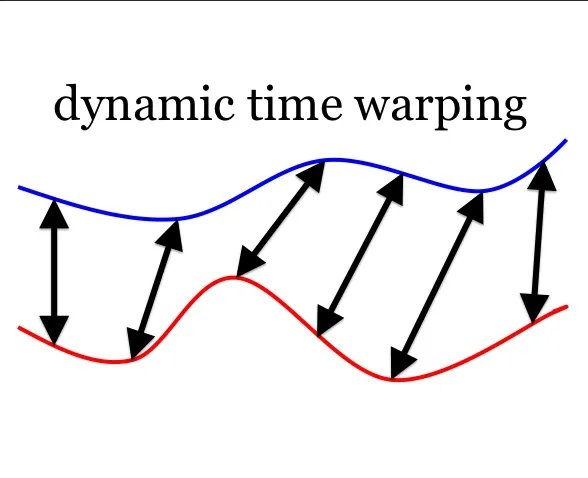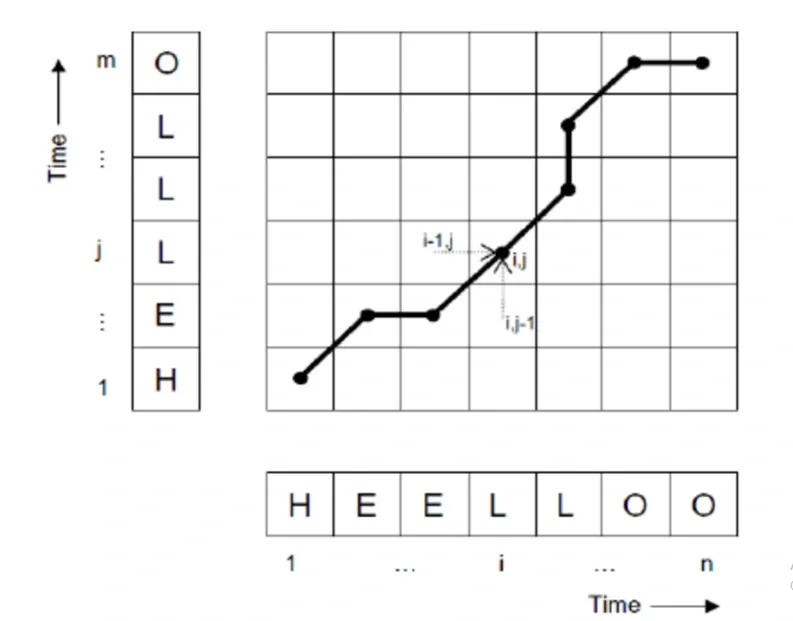What is Dynamic Time Warping?
When comparing two-time series data, like speech patterns or stock prices, simple techniques often fall short. Dynamic time warping (DTW) steps in as a powerful method to find the best alignment between these sequences.
Whether the series are of different lengths or vary in speed, DTW adjusts for these differences, making it a reliable tool in data analysis. This method is widely used in various fields, proving its value in practical applications.
How Dynamic Time Warping Works?
Dynamic time warping works by aligning two sequences to minimize the differences between them. It doesn’t just compare points that match directly but stretches and compresses parts of the series to find the best alignment.

Basic Concept of Aligning Sequences
The basic concepts of aligning sequences are the following:
- Flexible Alignment: Dynamic time warping adjusts the timing of sequences, allowing you to compare similar patterns even if they occur at different speeds.
Think of comparing two heartbeats; one might be faster, but DTW aligns them to show they follow the same rhythm.
- Handling Different Lengths: Sequences of different lengths can be challenging to compare. Dynamic time warping aligns the start and end points, ensuring a meaningful comparison.
Imagine comparing a long speech to a short summary; DTW ensures the key points match.
- Minimizing Differences: Dynamic time warping finds the path that minimizes the differences between two sequences, even if one has pauses or irregularities.
This is like comparing two songs, where one has an extra verse; DTW aligns them to highlight the similarities.
Applications of Dynamic Time Warping
Dynamic time warping is not just a theoretical concept; it has practical uses across many fields. Whether you're analyzing speech, tracking stock prices, or comparing biological data, DTW is a valuable tool.
Common Areas Where Dynamic Time Warping is Used
The common areas where dynamic time wrapping is used are the following:
- Speech Recognition: Dynamic time warping helps match spoken words to known words, even if the speaker talks quickly or slowly. If two people say "hello" at different speeds, DTW aligns them to show it's the same word.

- Finance: In finance, Dynamic time warping compares stock price movements over time, even if one stock moves faster than another. It helps investors see similar trends across different companies.
- Biology: Dynamic time warping aligns DNA sequences that might have mutations or variations. This allows researchers to compare genes across species, even when the sequences aren’t identical.
Suggested Reading:
Advantages of Dynamic Time Warping
Dynamic time warping offers several benefits that make it a go-to method for comparing time series data. Its ability to handle variations and differences sets it apart from simpler methods.
Flexibility in Handling Variations in Speed
The advantages of flexibility in Dynamic time warping are the following:
- Adjusts to Timing Differences: Dynamic time warping can compare sequences even if they are stretched or compressed. This makes it ideal for comparing data like heart rates or speech, where timing can vary.
- Aligns Similar Patterns: Dynamic time warping focuses on matching patterns rather than exact points. This is useful in fields like finance, where trends matter more than precise timings.
- Useful for Real-World Data: Dynamic time warping's flexibility makes it practical for real-world data, where perfect alignment is rare. It adapts to the data's natural variations, offering a more accurate comparison.

Ability to Compare Sequences of Different Lengths
Having the ability to compare sequences of different lengths:
- Works with Unequal Lengths: Dynamic time warping can compare sequences of different lengths by aligning their key points. This is helpful in areas like speech recognition, where recordings might be cut short.
- Focuses on Key Similarities: Dynamic time warping identifies the core similarities between sequences, ignoring minor differences in length. This is valuable in biology, where sequences might have insertions or deletions.
- Adapts to Incomplete Data: Even with missing data, Dynamic time warping finds the best alignment, making it robust for practical.
Limitations of Dynamic Time Warping
While Dynamic time warping is powerful, it’s not without its downsides. Understanding its limitations helps in deciding when and how to use it.
High Computational Cost
The high computational cost of Dynamic time warping is a limitation as:
- Resource-Intensive: Dynamic time warping requires significant computational power, especially for long sequences. This can be a challenge in real-time applications or with large datasets.
- Slower Processing: Because Dynamic time warping compares every point in both sequfences, it can be slow. This makes it less suitable for quick comparisons or large-scale data analysis.
- Not Ideal for All Applications: Due to its high cost, Dynamic time warping might not be the best choice when speed is a priority. Simpler methods might be more appropriate in these cases.
Suggested Reading:
Sensitivity to Noise and Outliers
Dynamic time warping is quite sensitive to noise and outliers causing certain limitations, like:
- Affected by Irregularities: Dynamic time warping can be sensitive to noise in the data, which can distort the alignment. This is a concern in fields like finance, where data can be volatile.
- Prone to Overfitting: Dynamic time warping might overfit to minor fluctuations, leading to less meaningful comparisons. In speech recognition, this could mean aligning to background noise instead of the actual words.
- Requires Preprocessing:To use Dynamic time warping effectively, data often needs to be cleaned and normalized first. This adds an extra step, making the process more complex.
Frequently Asked Questions (FAQs)
How does Dynamic Time Warping work?
Dynamic Time Warping works by aligning two sequences to minimize the differences between them. It creates a distance matrix and finds the optimal warping path to compare similar patterns, even with timing variations.
What are the advantages of Dynamic Time Warping?
Dynamic Time Warping offers flexibility in handling variations in speed and length, making it ideal for comparing time series data in real-world applications where exact alignments are rare.
What are the limitations of Dynamic Time Warping?
Dynamic Time Warping has high computational costs and is sensitive to noise and outliers. This makes it resource-intensive and sometimes less suitable for real-time or large-scale data analysis.
Can Dynamic Time Warping be used with Python?
Yes, Dynamic Time Warping Python libraries like dtaidistance and fastdtw are popular for implementing DTW. These libraries simplify the process of applying DTW to various time series data.
What are alternatives to Dynamic Time Warping?
Alternatives to Dynamic Time Warping include Euclidean distance, FastDTW, and correlation-based methods. These methods may be faster or more suitable depending on the specific needs of your time series analysis.
